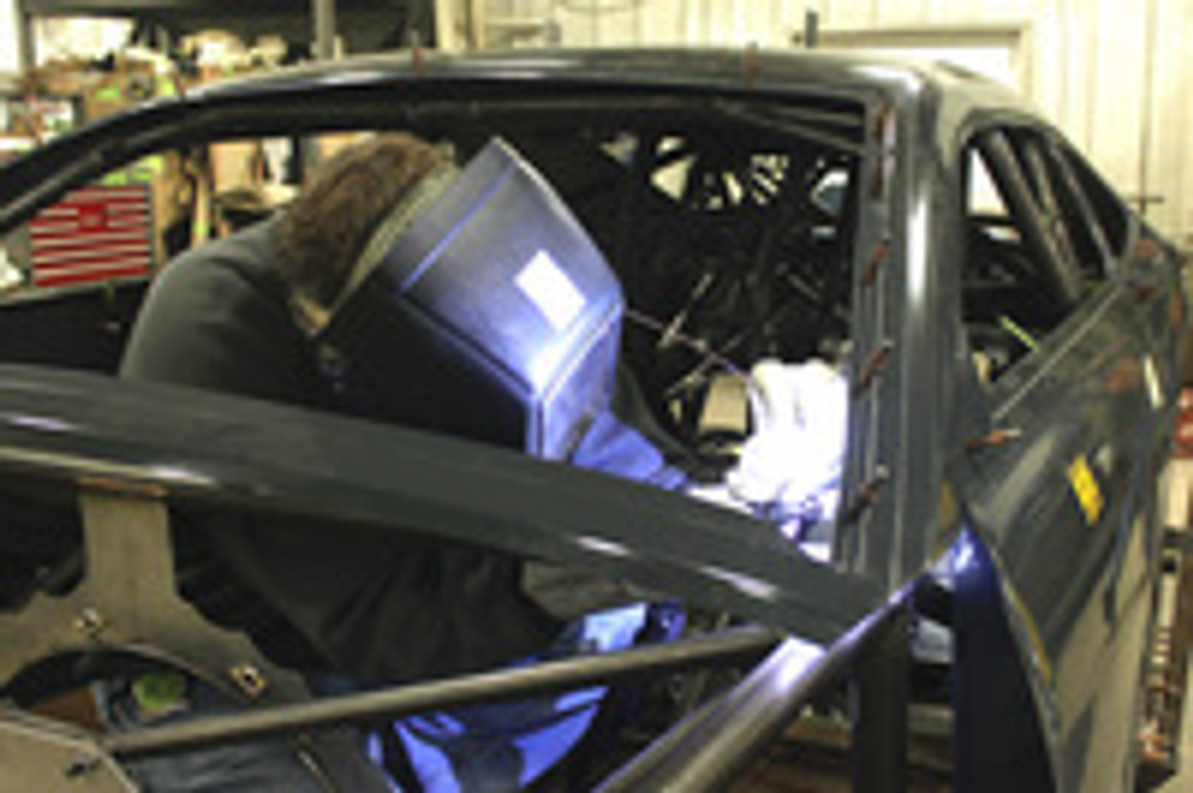Extra-Mile Approach Separates Builders Like Rick Jones From The Rest
Extra-Mile Approach Separates Builders Like Rick Jones From The Rest
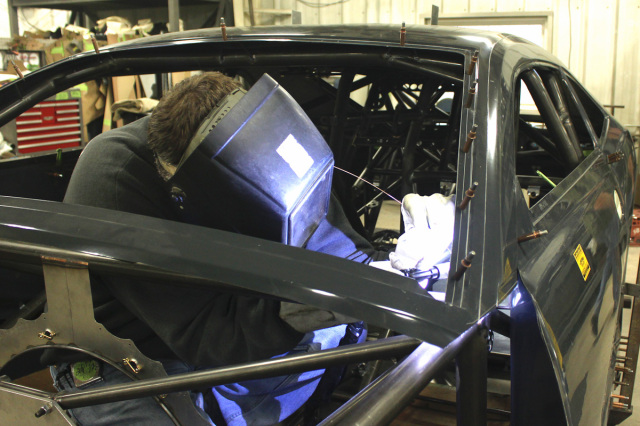
There are hundreds, if not thousands, of chassis builders around the world churning out drag racing machinery for competitors at every level, but the number of truly elite builders can be counted on less than one hand, and Galesburg, Illinois-based Rick Jones Race Cars is certainly on that short list. Founded in 1987, the family owned chassis fabrication and parts manufacturing operation has long been among the sport’s most respected and innovative builders, and their focus on both performance and craftsmanship has led their customers to innumerable world championships and race victories across the vast spectrum of drag racing.
While Jones, his son, Rickie, and their entire 25-person staff have established themselves as one of the premier builders and a mainstay in the sport’s most technologically advanced category of NHRA and IHRA Pro Stock, that very same degree of innovation and quality is put into the chassis they build for everything from Pro Modified to Top Sportsman, Super Gas, and bracket racing. Jones and his staff provided us with a rare inside look at just such a race car— or a matching pair of cars, rather — being assembled from start to finish inside their 30,000 square foot facility, as well as a glimpse behind the scenes at their Quarter-Max chassis and racing components mail order division.

In this walk-through of Rick Jones Race Cars’ facility, we’ll be taking a look at the construction of not one, but two matching 2012 Chevrolet Camaro Super Gas cars that feature many of the tricks built into a typical example of upper-tier race machinery.
The Warn Racing team of Stephanie Skaggs and Ashley Warn out of Northern California are returning customers; they had a Pontiac Grand Am for Super Gas racing constructed there years ago. With plans in the works to build a pair of 2014 Chevrolet Camaros for NHRA Super Gas competition, they once again turned to RJ Race Cars to build them top-of-the-line machines utilizing some of the very same technology and tricks of the trade learned from their Pro Stock efforts, like the Camaro that Erica Enders-Stevens drove and the father and son Jones team recently tuned to the NHRA world championship.

A number of steps are involved in getting a new car project off the ground, which takes some considerable communication between Jones’ staff and the customer. The customer’s goals must be discussed and parts planned out and ordered. The driver must also be measured and later fitted to the car. In some cases, a poured seat may also be made with the driver present.
To The Drawing Board
When a customer first makes the decision to have a car constructed by RJRC, Jones and his team sit down with the customer and discuss their needs, from the category or categories it’s intended to compete in, the body style they’re looking for, the engine, power adder, and transmission combination, and a long list of other checklist items. From there, Jones says, they can take those requirements and determine the wheelbase, the shocks and struts, wheels and tires, and other attributes of the build catering it to those needs. There are also a myriad of options, as well, for those with specific requests. It all comes down to a customer-first approach.
“We definitely want to give our customer what they want. There’s a lot of communication that has to exist along the way. Many people come to us and direct us to simply build them a car as if it were our own, but there’s still a lot that goes into these cars where we work closely with them, from flying them in get fitted to get the steering wheel, seat, pedals and everything comfortable for them, getting their engine and drivetrain shipped in, and coordinating with all of the vendors.

The chassis are constructed by a team of highly experienced welders and fabricators, using chassis jigs with multiple fixtures that help them align the bars and form the angles to the proper measurements.
Building a race car is a lot like building a house,” Jones continued. “There’s just a lot of items that go into the car. Some parts we stock here every day, but others we have to order to ensure they’re here in a timely manner.”
Chassis Fabrication
The RJRC race car fabrication facility is set up in “stations” that are specific to each segment of the build. This ensures that those with the skills and the experience in different areas can lend their expertise to a process, whether it’s chassis fabrication, tinwork, mounting the body, or wiring and plumbing. The first step, of course, is chassis construction. This is where many of the trade secrets are instituted, with JJ Coe, a 25-plus year veteran of chassis construction, heading up the process on each and every race car. RJRC uses a proprietary fixture plate for the chassis fabrication, with a number of jigs and fixtures they’ve developed to streamline the build and ensure measurements and angles are accurate.


“Event though we have these fixtures to help lay the bars in the correct location, it still takes a lot of raw talent to do what these guys do,” says Jones. “It’s extremely hard to build these chassis — it’s just years and years of training. The welding process is so important, ensuring you get good penetration and good welds so you won’t have any failures. They’re very good at what they do, and our guys here have all been doing for it a long time.”
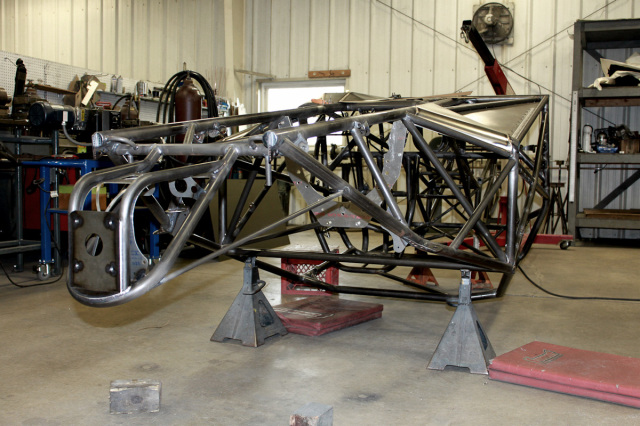
Once the basic chassis is complete, the focus turns to the interior and the many small parts and pieces that must be fabricated and welded to the chassis, including transmission mounts, the firewall, and other assorted tabs and brackets to mount individual components.
Turning Attention To The Interior
Once the chassis is complete, it’s wheeled to the next bay, where the interior becomes the central focus. Here the firewall, floors, transmission mounts, pedals, seat, dash, air bottle mounts, the transmission tunnel, and other cockpit components are made and installed. All of the tabs and mounts are also fabricated and welded or bolted to the chassis. To produce a floor with unmatched fit and finish, the chassis are actually turned upside down during this stage and the floors welded to the chassis, then turned back over.
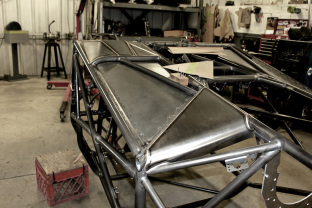

It takes a lot of hours to finish this process. There is at least 1400 hours in a typical build. It’s a tremendous amount of work to build a race car from start to finish. – Rick Jones
RJRC fully completes the interior before the Five Star-made body is test-mounted, allowing the staff full access to the cockpit. In the next bay, the body is fitted to the car using a proprietary chassis jig, along with the doors, windows, and spoiler. As the bodies on Warn Racing’s two cars are composite replicas of the Chevrolet Camaro, they’re glued to the chassis at specific mounting points to maintain the structure of the car and inhibit flex as the car launches and at speed. This final process of gluing the body doesn’t come until later, however.
A host of other parts and pieces then must be fabricated and installed, ranging from door seals to rocket panel mounts, wheel tubs, the trunk floors, the rest of the spoiler bracketry, mounting of the hood scoop, the parachute mounts, and a laundry list of other odds and ends to finalize the mechanics of the cars.
At this stage, the car is largely finalized from a fit and finish standpoint. Anything that needs to be fabricated and welded to the chassis has been finished, and all of the integral components have been checked for fit. Which is followed by the fun part — completely disassembling the car down to the bare chassis for powder coat.
Upon returning from powdercoat, the body is finally glued to the chassis. The bodies can either be left unfinished, or painted in-house if the customer so chooses. RJRC works exclusively with SD Enterprises in Michigan, one of the best-known custom painters in drag racing, who drive down to pick the cars up, work their magic, and return the car for final assembly.
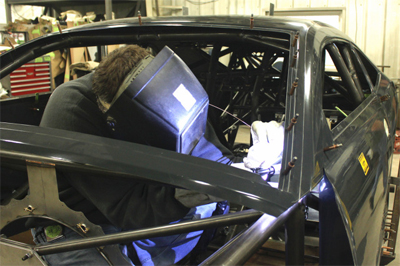


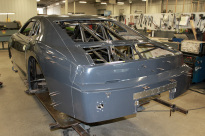
Final Assembly And The Quarter-Max Advantage
After all of the tabs, mounts, and other pieces are installed and the components have been test fit, the body is test-mounted on the chassis for fit in order to align all of the braces, door mounts, and connection points.
Rickie, the second-generation craftsman, then heads up the often tedious process of wiring and plumbing the entire car, as well as final assembly of everything from the interior panels and components to installation and setup of the suspension. “It takes a lot of hours to finish this process — at least 1300 hours in a typical build. It’s a tremendous amount of work to build a race car from start to finish,” says Jones.
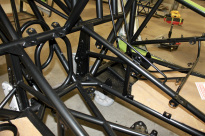
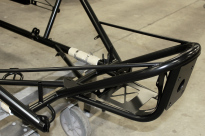
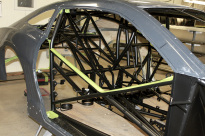
As he shared with us, a typical car will require around 1,300 hours of work to complete, with eleven people typically assigned to race car construction.With the chassis deemed complete and everything test-fit, the cars are then stripped down to the chassis for powdercoating. Upon their return, Jones' son, Rickie, oversees the final assembly of the cars.
As part of the final assembly, RJRC also forms all of their own headers in-house, which is a process many smaller shops will source out or bring in a header builder to handle. This is just another step that Jones’ team takes to maintain complete control over the build.
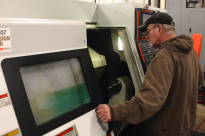
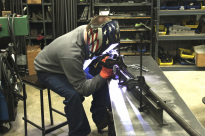

Many of the components found of the Warn Racing Camaros, and even on RJRC’s Pro Stock cars, are available directly out of the Quarter-Max catalog. In essence, that same technology and quality is made available to anyone, not just those with the budget to have a complete car constructed. These include a RJ Pro 4130 custom nine-inch floater housing, Pro Series 4-link brackets, RJ Extreme Series Slim-Line wheelie bar kit, and a number of other catalog components.The very same parts that are fabricated in-house and installed on an RJ Race Cars can be purchased through the company's Quarter-Max mail order division. Jones has a staff that's solely dedicated to developing and building new parts that are tested on their own race cars and installed on cars like those for Warn Racing or made available via the Quarter-Max catalog.
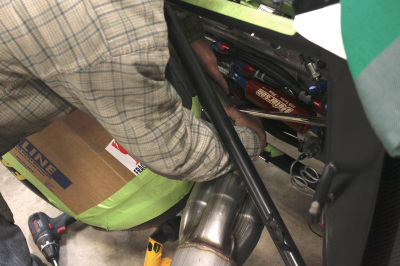
RJ Race Cars keeps as much of the process of building a race car in-house as possible. This includes building all of their own headers to perfectly match each and every race car. This is done not only to keep a tight lid on quality control, but to ensure every car is perfect, so its fit and finish when it rolls out the door ensures that it’s virtually ready-to-run.
Like you would expect of an operation that produces both complete race cars and countless catalog components for smaller chassis shops and do-it-yourself’ers, RJRC has complete machining and manufacturing capabilities in-house, with industrial-grade equipment including Mazak five-axis CNC’s and OMAX water jets. As Jones shares with us, having this equipment at their disposal is a great advantage to their operations, as prototype parts can be created and tested under their guidance, with minimal additional time or expense that might be needed if it were outsourced.
“When we come up with a new product, we can design and manufacture a part here at our facility, and then we can see how it fits on our car, how well it works, and we can actually test it on the track in our own Pro Stock car and develop that item. From there, we can put into production and add it to our Quarter-Max catalog for the public to purchase. We strive to control everything and do it here in our facility,” says Jones.



As Jones goes on to share, a small percentage of their components are sourced to outside manufacturing facilities, when their production isn’t justifiable in-house. But the remaining parts are being produced by a dedicated staff, five days a week. Seven members of the staff are dedicated solely to parts production, and will typically average 150 to 200 parts a week, but that number can fluctuate depending on what parts are on-deck. Between in-house parts and those sold as an official retailer from another manufacturer, Quarter-Max will typically stock 10,000 to 15,000 catalog parts at any given time.During final assembly, the composite body is glued to the chassis using several specific mounting points.
We race the cars we build, so we feel we really know how to build a great car. When they leave here, they’re set up correctly and they go right down the race track. – Rick Jones

At the end of the day, Jones says he and his team take great pride in the safety aspect of their cars, more than anything else. That focus, along with elite-level performance, is why customers like the Warn family return for their next race car.
“We know the welds on these cars are done as well as they can be, and that the car will stand up to nearly any type of crash one might go through. That’s important for us. If anything were to happen, we want the driver to survive, and we build a lot of safety things into the cars to accomplish that.
“We race the cars we build, so we feel we really know how to build a great car,” Jones continues. “When they leave here, they’re set up correctly and they go right down the race track.”
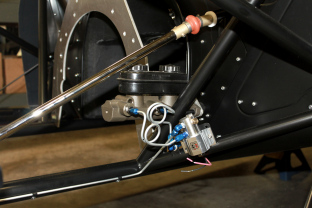
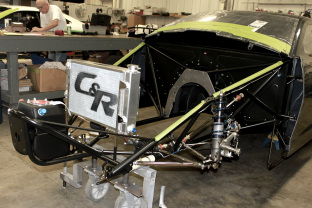
The final assembly stage is the most labor and time intensive of the build, as every electronic and plumbing system in the car must be routed, installed, and tested. Along with testing for proper functionality, Jones' staff also makes each car race-ready by setting up the suspension, the wheelie bars, all of the gauges, and so on.
Jones credits Rickie for that degree of quality at the conclusion of the build, not only getting the car set up, but ensuring that every single system, button, lever, and electronic device on the vehicle works before it ever goes out the door. It’s that extra-mile approach that separates builders like Rick Jones from the rest, and it’s the very reason why they sit among the sport’s elite chassis builders, year after year.
Article by Dragzine.com
Recent Posts
-
The Third Stage: Prepping the Chassis for Paint with Quarter-Max Racing
Get an exclusive look behind the scenes at Quarter-Max Racing! Join Clyde Scott as he walks you thr …Oct 6th 2025 -
Robin Roberts Captures Hometown Pro Mod Victory at MWDRS Smack Down
An exciting weekend at Flying H Drag Strip in Odessa, Missouri, gave the MWDRS first time winners, n …Sep 24th 2025 -
Mounting a One-Piece Front End: The Complete Quarter-Max How-To Guide
Mounting a one-piece front end on your race car? This DIY guide from Quarter-Max Racing is for you. …Sep 10th 2025

